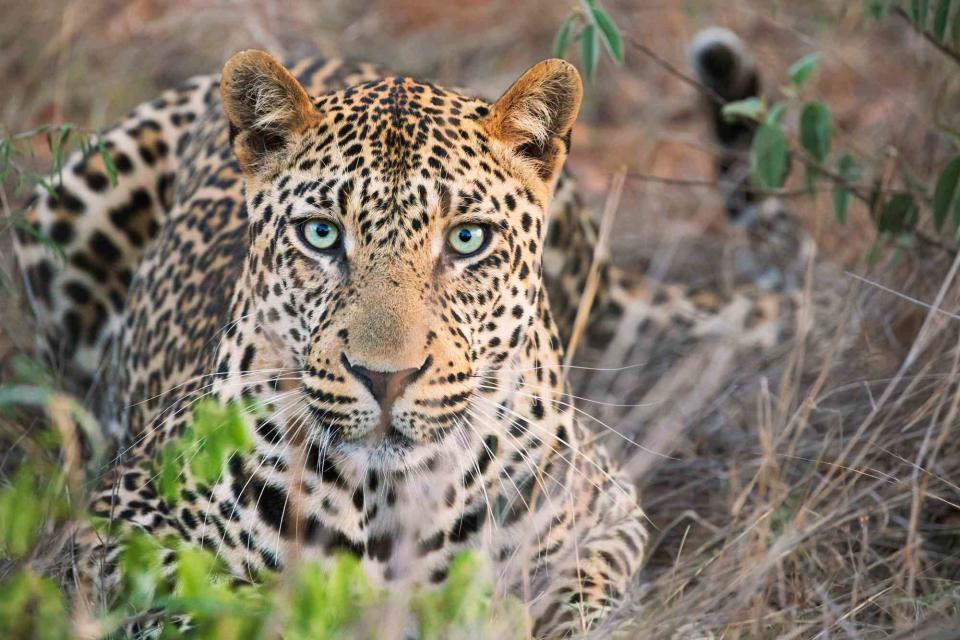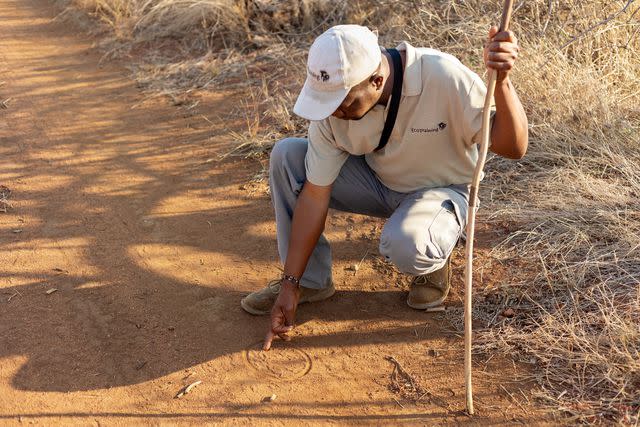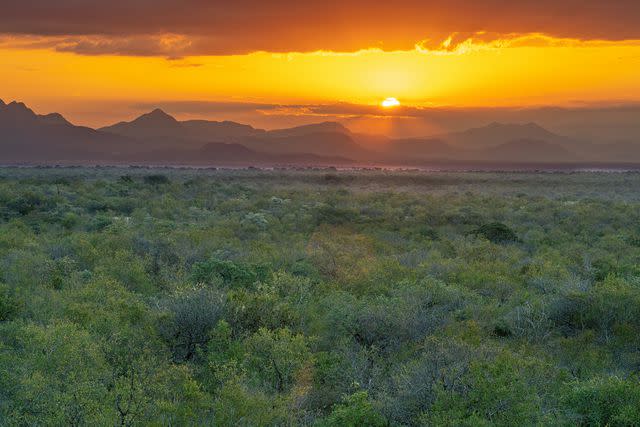This Wilderness Course in South Africa Teaches Real Ranger Skills — Like How to Safely, Respectfully Track Leopards
The programs range from seven-day classes to yearlong accredited curriculums.

Courtesy of Leopard’s Lair Bush Lodge
A leopard crouches in the grass in South Africa’s Limpopo province.Things were not going according to plan.
I sat in an open-air game cruiser vehicle in South Africa’s Pridelands Conservancy, lurching along an ever-muddier road that threatened to sink both our wheels and our spirits. Unseasonable weather had brought some of the worst rains in years — rains that were persistent enough to cancel game drives.
But I wasn’t there for a traditional safari. This trip was all about leopards, and yet I wouldn’t see a single one — that was part of the point.
Pridelands is the location of one of six bush camps owned by EcoTraining, an education company that runs accredited courses in safari guiding and wildlife tracking across South Africa, Botswana, Kenya, and Zimbabwe. To date, the company has trained more than 13,000 people from 33 countries. One important skill taught to guides is habituation, which involves exposing animals to the same stimulus (such as a group of people in a vehicle) repeatedly until they get used to it. It’s a slow, delicate process. Experienced trackers can spend hundreds of hours following wildlife and acclimating them to humans. The goal is a comfortable, unstressed wild animal: a habituated lion or cheetah, for example, will continue lounging, hunting, or doing whatever it was doing in the presence of a game cruiser, rather than fleeing.

Marie Schmidt/Courtesy of EcoTraining
Tracker Morris Chovede examines a leopard pawprint during an EcoTraining habituation course.I wanted to understand habituation — specifically, the habituation of South Africa’s elusive leopard. Anyone 16 years or older can take one of the EcoTraining courses, which range from a seven-day EcoQuest class (which teaches basic bush skills and African ecology) to a one-year accredited professional field guide curriculum (which includes postings at lodges and game reserves). Custom experiences, like the leopard habituation I had eagerly signed up for, are available by request.
Back in the game cruiser, EcoTraining’s expert tracker Morris Chovede scanned the ground ahead for our target’s distinctive pugmark, but even he couldn’t follow tracks through what now resembled melted chocolate ice cream. All we could do was wait for the rain to stop — one of many moments that illustrated how tracking leopards demands patience.
“They are very skittish,” said the soft-spoken Chovede, who knows all of Pridelands’ spotted “regulars” well. “If you don’t habituate them, they will run away once they hear the vehicle. You would never see them.”
I thought about those words later that day, when I was once again warm and dry back at camp. I was staying at Leopard’s Lair Bush Lodge in Hoedspruit Wildlife Estate, a 25-minute drive from the Pridelands EcoTraining camp, where trainees typically stay, which has 10 basic dome tents with shared bathroom facilities. (EcoTraining arranged my more luxurious upgrade, which included such creature comforts as air-conditioning and a Jacuzzi.)

Courtesy of Leopard’s Lair Bush Lodge
Trainees can stay at Leopard’s Lair Bush Lodge, in Hoedspruit Wildlife Estate.The following morning, Chovede pointed out a trail of perfectly formed pawprints in the ash-gray soil of a riverbank. A male leopard’s print is broader, Chovede said, while the female’s — like the palm-size ones we were seeing — has a smaller, more slender profile. Both sexes tread lightly and move unpredictably, so environmental cues, such as impalas all staring in one direction or making their characteristic alarm call, are important, he said.
“Leopards are the epitome of stealth, camouflage, and cunning,” Anton Lategan, the burly, affable co-owner and managing director of EcoTraining, told me on the phone shortly after my trip. A former guide himself, Lategan said that the practice of habituation in South Africa began in the 1970s in early reserves such as Londolozi, Mala Mala, and Sabi Sabi, where many of the skills were learned from the local Shangaan people. The process starts when a tracker spots a leopard, then carries out a “spot ID,” identifying the cat by the unique pattern above its whiskers. Photos and videos are taken, and the animal is given a name: Pixie Pan (one of Pridelands’ original females, around eight years old), Marula (Pixie Pan’s daughter), and Twin Spot (a young male). Trackers typically use a safari-style vehicle to follow the leopards (Lategan asks his to maintain a respectful distance of at least 300 feet) to familiarize the animals with the vehicle’s appearance and noise.
Trackers prefer to habituate female leopards because they have smaller territories, Chovede told me as we circled a rocky hill where he’d seen females hide their young. More importantly, females typically produce cubs about once a year — and that’s when something interesting happens.
“If you can get the mother to trust you, her cubs are going to grow up trusting you more than she does,” Lategan said. “Then those cubs go on to have cubs, which become even more comfortable around people. And so the cycle goes.”

Vinicio Herrera
Sunset over the Drakensberg Mountains in South Africa’s Pridelands Conservancy.While every animal is different, each new generation generally takes less time to habituate. Some rangers may try to “fast-track” the process by positioning an impala carcass in a tree and then lying in wait for the leopards, but Lategan prefers the longer but more respectful approach of gradually moving closer on successive encounters, depending on the animal’s comfort level. “It’s likely Pixie Pan was hunted by people before she got here, so the memory of being threatened by humans is in her psyche,” Lategan continued. “It’ll take years before she’s truly comfortable around us. But her cubs might take just months because their experience with humans is one of respect, rather than fear.”
Ultimately, the leopards decide when they’ll reveal themselves. Late into my final day in the Pridelands Conservancy, we glimpsed from afar a female leopard who’d spooked a troop of baboons but remained hidden when we approached. “She’s here,” Chovede said, “but she doesn’t want to show her face.” It was a reminder of the importance of the ongoing work done by people like Chovede and Lategan — and the value of cultivating a relationship between leopards and humans built on trust.
Lategan had a more poetic analogy.
“It’s like what Nelson Mandela said — no one is born with prejudice,” Lategan said. “It’s easier to teach love than hate.”
ecotraining.co.za; seven-day custom EcoTraining ranger experience from $1,603 per person.
A version of this story first appeared in the April 2023 issue of Travel + Leisure under the headline "On the Prowl."
For more Travel & Leisure news, make sure to sign up for our newsletter!
Read the original article on Travel & Leisure.

